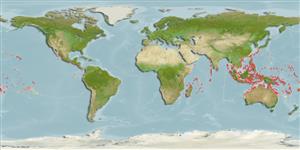Classification / Names
Common names from other countries
Main reference
Size / Weight / Age
Max length : 9.5 cm TL male/unsexed; (Ref. 90102)
Environment
Marine; reef-associated; depth range 2 - 20 m (Ref. 90102)
Climate / Range
Tropical, preferred ?
Distribution
Short description
Dorsal
spines
(total): 7;
Dorsal
soft rays
(total): 9;
Anal
spines: 2;
Anal
soft rays: 13 - 15. Diagnosis: Rays: dorsal VI + I,9; anal II,13-15; pectoral rays 14 (rarely 13 or 15). Gill rakers 5-6 + 15-17. Lateral-line scales 25+3-5. Median predorsal scales 5-7. Body depth 2.4-2.7 in SL; body width 2.3-2.6 in body depth; eye diameter 2.55-3.0 in head length; first dorsal spine 2.0-2.9 in second spine; second dorsal spine 2.3-2.9, and third dorsal spine 2.4-2.8 in head length; spine of second dorsal fin 2.3-2.8, and second anal spine 2.6-3.2 in head length; pelvic-fin length 4.5-5.15 and caudal-peduncle length 4.3-5.4 in SL; distance from insertion of pelvic spine to anal-fin origin 3.8-4.8 in SL. Basilingual teeth absent. Posterior preopercular edge completely serrate, or nearly so; ventral edge serrate on posterior half. Scaly sheath along anal-fin base poorly developed or absent (Ref. 54391).
IUCN Red List Status (Ref. 115185)
Threat to humans
Harmless
Human uses
More information
ReferencesAquacultureAquaculture profileStrainsGeneticsAllele frequenciesHeritabilityDiseasesProcessingMass conversion
Tools
Special reports
Download XML
Internet sources
Estimates of some properties based on models
Phylogenetic diversity index
PD50 = 0.5001 many relatives (e.g. carps) 0.5 - 2.0 few relatives (e.g. lungfishes)
Trophic Level
3.5 ±0.5 se; Based on size and trophs of closest relatives
Resilience
High, minimum population doubling time less than 15 months (Preliminary K or Fecundity.)
Vulnerability
Low vulnerability (11 of 100)
Price category
